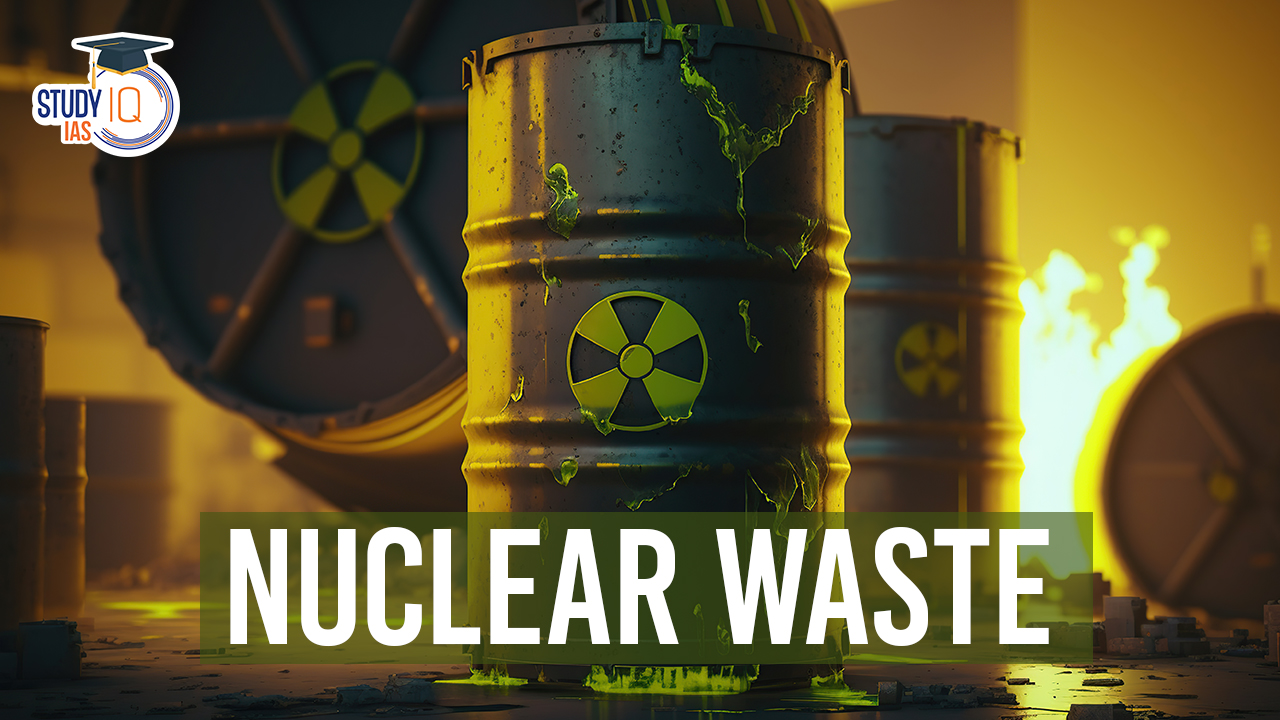Table of Contents
Context: India’s Prototype Fast Breeder Reactor marks a significant step in its nuclear program, emphasising the challenges of managing highly radioactive nuclear waste and the pursuit of energy independence through thorium utilisation.
What is Nuclear Waste?
Radioactive waste, or nuclear waste, is a byproduct originating from nuclear reactors, fuel processing facilities, medical institutions, and research centers. It can manifest in various states, including gas, liquid, and solid forms, with its radioactivity levels varying according to the specific waste material. The duration of radioactivity persistence can range from a matter of hours to several months, or even extend over hundreds of thousands of years.
Types of Nuclear Waste
Exempt Waste
This category encompasses waste that conforms to the criteria for exemption, clearance, or exclusion from regulatory control with respect to radiation protection.
Low and Intermediate-Level (LIL) Waste
LIL waste is characterized by low levels of radioactivity. It includes materials such as those used for handling highly radioactive components of nuclear reactors (e.g., cooling water pipes and protective clothing) and waste generated from medical procedures involving radioactive treatments or diagnostic X-rays, among others.
High-Level Waste
High-level waste possesses substantial levels of radioactivity and is primarily generated during the reprocessing of spent nuclear fuel. This waste comprises elements like uranium, plutonium, and other intensely radioactive isotopes formed through nuclear fission. Notably, high-level waste materials have exceedingly long half-lives, with some extending beyond 100,000 years. Consequently, it takes a significant amount of time for these materials to reach a safer level of radioactivity.
Nuclear Waste In India
India has a growing nuclear energy sector and a significant nuclear weapons program, both of which contribute to the production of nuclear waste. Here are some key points related to nuclear waste in India:
Nuclear Power
India has a growing nuclear power sector, with several nuclear power plants operational and more under construction. These power plants generate low and intermediate-level radioactive waste in the form of spent nuclear fuel, contaminated materials, and various other byproducts.
Reprocessing
India has facilities for reprocessing spent nuclear fuel, such as the Bhabha Atomic Research Centre (BARC) and the upcoming Advanced Fuel Fabrication Facility. Reprocessing is done to recover fissile material and reduce the volume of nuclear waste.
High-Level Waste
Reprocessing facilities generate high-level radioactive waste, which includes materials with long-lived radioactive isotopes like plutonium. Proper disposal of high-level waste is a significant concern in India, as it requires long-term management and isolation.
Radioactive Medical and Industrial Waste
India also generates radioactive waste from medical and industrial applications, including radiation therapy, radiography, and industrial radiography. These sources contribute to the low and intermediate-level waste inventory.
Nuclear Waste in World Statistics
- In 2022, about 2.32 million cubic feet and 154 thousand curies of low-level radioactive waste were disposed of.
- The International Atomic Energy Agency (IAEA) estimates that about 370,000 metric tonnes of heavy metal (MTHM) of spent fuel has been produced since the start of civil nuclear power production. Of this, 120,000 MTHM has been reprocessed.
- The IAEA estimates that 392,000 tonnes of heavy metal (tHM) in the form of used fuel have been discharged since the first nuclear power plants began operation.
- More than a quarter million metric tons of highly radioactive waste is stored near nuclear power plants and weapons production facilities worldwide. Over 90,000 metric tons are in the US alone.
- Around 80 percent of this waste (close to 2 million m3) has been disposed of.
- The amount of nuclear waste is constantly increasing with no full disposal route anywhere.
We’re now on WhatsApp. Click to Join
Nuclear Waste Related Concern
Nuclear waste is associated with several significant concerns, and addressing these concerns is essential for the safe management and disposal of radioactive waste materials. Some of the key concerns related to nuclear waste include:
Radioactive Contamination
Nuclear waste contains radioactive isotopes, some of which can remain hazardous for thousands or even millions of years. Radioactive materials can emit ionizing radiation, which can damage living organisms and the environment if not properly contained and isolated.
Health and Safety Risks
Improper handling and storage of nuclear waste can pose health and safety risks to workers, the public, and future generations. Exposure to radiation can lead to various health issues, including cancer and genetic mutations.
Long-Term Storage
High-level nuclear waste, in particular, requires secure long-term storage solutions. Identifying suitable sites for deep geological repositories and ensuring their long-term integrity are complex challenges. The waste must be isolated from the environment for an extended period.
Transportation Risks
Transporting nuclear waste from its point of origin to storage or disposal facilities can present risks. Accidents or security breaches during transportation could lead to radioactive material release, which is a significant concern.
Proliferation Risks
Reprocessing nuclear waste to extract fissile materials, such as plutonium and uranium, can have proliferation risks. These materials could potentially be diverted for the production of nuclear weapons, which is a global concern.
Environmental Impact
Improper disposal of nuclear waste can lead to contamination of soil, water, and ecosystems. The long-lived nature of some radioactive isotopes makes this a concern for future generations.
Nuclear Waste Management
Nuclear waste management refers to the systematic handling, storage, and ultimate disposal of radioactive materials produced by nuclear power generation, research, and other nuclear-related activities. Proper management is essential to ensure the safety of both humans and the environment. Here are the key components of nuclear waste management:
- Generation: Nuclear waste is generated as a byproduct of nuclear processes, including nuclear power generation, reprocessing, and nuclear research. It can be in various forms, such as spent fuel, contaminated equipment, or radioactive liquids.
- Collection and Segregation: Radioactive waste is collected, segregated, and categorized based on its level of radioactivity and physical form. It is then properly packaged to prevent leakage and ensure safe handling.
- Storage: Radioactive waste is initially stored at the point of generation in secure containers and facilities. This can be short-term storage while awaiting transportation to more permanent storage or disposal sites.
- Transportation: Waste is transported from its generation site to interim or permanent storage and disposal facilities. This involves stringent safety measures to prevent accidents or radioactive material release during transit.
- Interim Storage: Low and intermediate-level waste is often placed in interim storage facilities, while a suitable long-term disposal solution is identified. These facilities are designed to safely contain waste for decades.
- Deep Geological Repositories: For high-level radioactive waste, the preferred method of disposal is deep geological repositories. These repositories are located deep underground in stable geological formations. The waste is placed in specially engineered containers and stored in such a way that it remains isolated from the environment for thousands of years.
- Reprocessing: In some cases, reprocessing is considered as a method to extract valuable materials from spent nuclear fuel and reduce the volume of waste. However, reprocessing also presents proliferation risks and complex challenges.
- Regulatory Oversight: Governments establish and enforce regulatory frameworks to oversee nuclear waste management, setting strict safety standards and guidelines to protect the public and the environment.
- Public Engagement: Public engagement and community involvement are critical in the decision-making process for selecting waste management sites. Building trust and addressing concerns are essential to successful waste management projects.
- International Cooperation: Given the global nature of nuclear waste issues, international cooperation is crucial. Organizations like the International Atomic Energy Agency (IAEA) work to establish best practices and standards for nuclear waste management.
Waste Management Challenges
- Spent Fuel Handling: Initially, spent fuel is highly radioactive and hot, necessitating up to several decades of underwater cooling before it can be safely transferred to dry cask storage for longer-term containment.
- Longevity: The radioactive nature of nuclear waste requires isolation from human contact for durations far exceeding the existence of anatomically modern humans, with some materials needing containment for millennia.
- Liquid Waste Treatment: Nuclear facilities also produce liquid waste, which, depending on the radionuclide content, may be treated and discharged, evaporated, chemically precipitated, absorbed, or incinerated.
- High-Level Waste Vitrification: High-level liquid waste, containing the majority of fission products, is turned into glass for safer, long-term storage.
Handling and Disposal Methods
- Dry-Cask Storage: After cooling, spent fuel is placed in steel cylinders, sealed, and stored in steel or concrete containers filled with inert gas.
- Geological Disposal: Waste is sealed in special containers and buried underground in stable geological formations, away from human activity, though risks of disturbance exist.
- Reprocessing: Spent fuel is chemically treated to separate fissile material for reuse, reducing waste but requiring specialised facilities due to the hazardous nature of the process.
Costs of Waste Management
- Economic Impact: The management of nuclear waste imposes additional costs on nuclear energy, accounting for a significant portion of the total waste management expenses across the nuclear fuel cycle.
- For Example: In a 1993 analysis, Dr. Tsyplenkov evaluated a 1,000 MWe nuclear power plant with a 70% capacity factor over 30 years. The study found:
- Initial Waste Management: 10% of total cost
- Depleted Uranium Handling: 1/3rd of initial cost (approx. 3.3%)
- Operational Waste Management: 24% of total cost
- Decommissioning Waste Management: 15% of total cost
- Waste Management at End of Cycle: 50% of total cost
- Total Cost per MWh: $1.6 – $7.1
- Initial Waste Management: 10% of total cost
- For Example: In a 1993 analysis, Dr. Tsyplenkov evaluated a 1,000 MWe nuclear power plant with a 70% capacity factor over 30 years. The study found:
International Examples and Challenges
- Accumulated Spent Fuel: Countries with established nuclear programs have amassed significant amounts of spent fuel, like the S. had 69,682 tonnes (as of 2015), Canada 54,000 tonnes (2016), and Russia 21,362 tonnes (2014), highlighting the global challenge of nuclear waste management.
- Accidents and Uncertainties: Incidents like the contamination scare at Germany’s Asse II salt mine and the accident at the U.S.’s WIPP facility underscore the complexities and uncertainties in long-term nuclear waste storage.
Nuclear Waste Treatment Technologies
Nuclear waste treatment technologies include:
- Radioactive waste disposal:Uses bioremediation technology to treat waste with microbes and plants
- Electrochemical treatment of radioactive waste:Uses high-temperature thermal treatment to reduce waste volume, retain toxic substances, and recover valuable substances
- Radioactive waste characterization: Determines important waste parameters and enables segregation of radioactive waste
- Deep geological disposal: Provides multiple barriers to prevent radionuclides from reaching the environment and exposing humans to radiation
- Vitrification: Immobilizes high-level liquid waste into inert vitrified borosilicate glasses
- Integrated waste management: Implements radioactive waste management solutions
Other nuclear waste treatment technologies include:
- Incineration of solid waste
- Evaporation of liquid waste
- Conditioning
Nuclear Waste Management in India
In India, the safe management of radioactive wastes is a multi-faceted process designed to protect human health, the environment, and future generations. This approach is underpinned by several key principles and stages of waste management, each aimed at ensuring the safety and security of radioactive materials.
India’s Approach to Nuclear Waste
- Reprocessing Facilities: India operates reprocessing plants in Trombay, Tarapur, and Kalpakkam, focusing on separating plutonium for both energy and weapons purposes.
- On-Site Management: Low and intermediate-level wastes are treated and stored at nuclear power station sites, with continuous monitoring to ensure safety.
- PFBR Considerations: The operationalization of India’s Prototype Fast Breeder Reactor (PFBR) introduces new dimensions to waste management, given its unique spent fuel characteristics.
Key Principles of Radioactive Waste Management
- Delay and Dilute: This principle involves delaying the release of radioactive waste into the environment and diluting its concentration to reduce the potential for harm.
- Concentrate and Contain: High-level radioactive waste is concentrated and isolated from the biosphere to prevent its dispersion and protect the environment.
Radioactive Decay and Hazard Reduction
Radiological hazards associated with short-lived wastes (those with half-lives of less than 30 years) naturally diminish over time due to radioactive decay. High-level waste, which contains both short and long-lived radionuclides, requires exceptional isolation from the biosphere, emphasizing the need for deep geological disposal.
Deep Geological Disposal
The long-term disposal of high-level radioactive waste is best achieved by identifying suitable geological formations in which the waste can be buried. This process, known as deep geological disposal, provides an effective barrier to prevent the release of radioactive materials into the environment.
Low-Level Waste Disposal
Low-level waste, characterized by its lower radioactivity and shorter half-lives, is comparably straightforward to dispose of. Allowing low-level waste to decay for a period of 10 to 50 years reduces its radioactivity, at which point it can be disposed of as regular refuse.
Treatment and Conditioning of Solid Waste
In various nuclear installations, substantial quantities of low and intermediate-level solid waste are generated, often with diverse characteristics. Treatment and conditioning processes are employed to reduce waste volume and minimize the mobility of radioactive materials. These processes encompass multiple steps and a variety of technologies, ensuring the safe handling and eventual disposal of the waste.
Nuclear Fission Vs Nuclear Fusion
| Aspect | Nuclear Fission | Nuclear Fusion |
| Definition | The nucleus of an atom splits into lighter nuclei through a nuclear reaction. | Two or more light nuclei collide to form a heavier nucleus. |
| Fuel Type | Uranium is mostly used in nuclear reactors to produce electricity. | Hydrogen isotopes (Deuterium and Tritium) are used in experimental reactions. |
| Byproducts | Fusion does not create many radioactive elements as a byproduct. | Fission creates many highly radioactive elements as a byproduct. |
| Energy Release | Tremendous energy is released (1 million times greater than other energy sources) when each atom splits. | Energy released during fusion is several times greater (3-4 times greater) than in fission. |
| Conditions Required | Fission requires atoms with critical mass and neutrons with high speed. | Fusion requires very high density, very high temperature and suitable light-weight atoms. |
| Natural Occurrence | Does not occur naturally in nature. | Occurs in stars (including the sun). |
| Energy Requirement | Requires less energy to split an atom. | High energy needed to fuse two or more atoms together. |
| Applications | Used in nuclear power reactors for energy production. | Not yet harnessed for practical energy production. |
| Example | Atomic bomb (based on nuclear fission). | Hydrogen bomb (based on nuclear fusion). |
Nuclear Waste UPSC
Nuclear waste, a byproduct of nuclear activities, varies in radioactivity and persistence. India’s nuclear endeavors produce diverse waste types, necessitating robust management. Concerns include contamination, health risks, long-term storage, transportation, and proliferation risks. Effective management comprises various stages like waste generation, collection, storage, transportation, interim storage, deep geological repositories, and reprocessing. Treatment technologies stabilize waste. India follows key principles in waste management, addressing both short-lived and high-level waste, allowing low-level waste to decay before disposal, and ensuring safe handling of solid waste. International cooperation and public engagement are vital in this endeavor.


 Mental Healthcare in India, Scope and Go...
Mental Healthcare in India, Scope and Go...
 Most Commonly Used Cancer Drugs and Thei...
Most Commonly Used Cancer Drugs and Thei...
 India Launched AI-Powered Traffic Manage...
India Launched AI-Powered Traffic Manage...





















